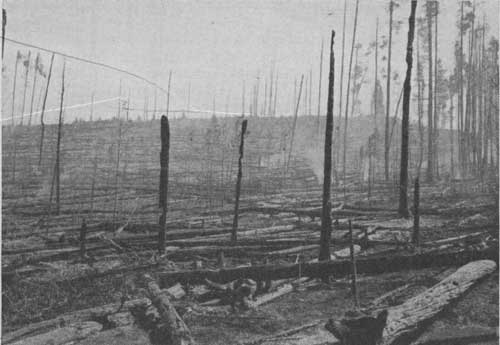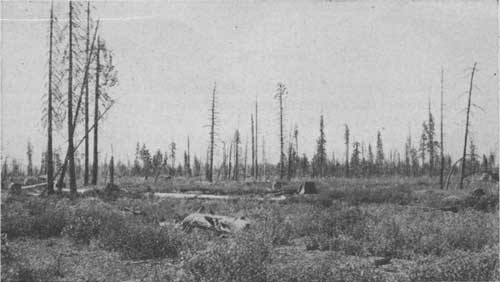|
The National Forests of California Miscellaneous Circular No. 94 |

|
ADMINISTRATION OF NATIONAL FORESTS
The Federal "forest reserves" in California were transferred to the Department of Agriculture and became "national forests" in 1905. They have, therefore, been under administration as national forests for more than 20 years. With the change in name came an altered conception of what the forests should be. By and large, their development has been the outcome of the viewpoint which sought usefulness of the resources for all the people in place of "reservation" solely for the future. The national forests have thus become a permanent public undertaking, their purposes understood and indorsed.
The unit of national forest administration is the ranger district, in charge of a district ranger. He is the local representative of the Forest Service whose duty it is to protect the forest from fire, regulate and supervise the grazing of stock and the sale of timber, and oversee the building of trails, telephone lines, and all other improvements necessary for the use and protection of his district. Briefly, the forest ranger is the custodian and manager on the ground of the Government's and the people's interests.

|
|
FOREST RANGER The forest ranger is the custodian and manager of the Government's and people's interests in the national forests (F—199850) |
A certain number of ranger districts form a national forest, the boundaries of which are determined largely by topographic features. A forest supervisor, who is the business and resource manager and executive of this larger unit, is in charge, with ample authority and discretionary powers to care for and develop to the fullest use the resources under his jurisdiction.
The Federal forests in various States or regions are further grouped together into national forest districts, as, for example, the national forests of California and southwestern Nevada, which constitute the California district. Each such district is in charge of a district forester, who gathers into his headquarters office the executive heads necessary to coordinate and administer all lines of work and activities on the forests. His office includes a fiscal agent, and technicians in charge of forest management, grazing, research, and other forms of scientific work which apply to the district as a whole. The district forester also deals directly with the State board of forestry, State fish and game commission, State highway commission, and other organizations, both public and private, in State-wide cooperative work. The national forests as a whole are administered by the Forester whose headquarters are at Washington, D. C.

|
|
A SUMMER HOME IN THE FOREST Five thousand summer homes have been built in the national forests of California on land leased from the Forest Service (F—200538) |
NATIONAL FOREST RECEIPTS
The total value of all resources in the 18 national forests of the California district is conservatively estimated at $300,000,000. The receipts of these forests, which accrue from sales of timber, grazing fees, water power, special-use permits, and other miscellaneous business, have totaled in recent years more than $1,000,000 annually.
Under existing laws 25 per cent of these receipts are returned, in lieu of taxes, to the State for distribution to counties for road and school development. An additional 10 per cent of the receipts is also expended by the Forest Service for roads and trails in the national forests. Since the passage of these laws in 1908 and 1913, respectively, more than $3,500,000 of national forest receipts have been returned to or expended in the State for schools, roads, and trails.

|
|
LAKE TAHOE, "THE GEM OF THE SIERRAS" It must surely be the fairest picture the whole earth affords.—MARK TWAIN |
ROADS AND TRAILS
With the growing interest and activity in the construction of better roads throughout the Nation, there has come a general demand for Federal-aid roads traversing the national forests. Congress, in taking action on this demand, has recognized that forest roads are required (1) to facilitate the administration, protection, and development of the Government's own properties in order that they may be safeguarded and made of maximum service to the public; (2) to serve as essential links in the public highway system constructed and maintained in cooperation with States and counties. A number of measures have therefore been enacted since 1912 under which nearly 1,200 miles of roads and 2,200 miles of trails have been constructed within or adjacent to the national forests of the State. In addition to this work, over 2,500 miles of existing roads and approximately 7,000 miles of trails are maintained in a satisfactory condition for travel. The allotment for roads and trails in the national forests of California is now nearly $1,250,000 annually, and the total of Federal funds expended to date on this work is in excess of $7,800,000.
The Bureau of Public Roads, in cooperation with the Forest Service and the State highway commission; locates and constructs the more important road projects. In the building of the cheaper roads and in trail work the Forest Service utilizes its field organization of supervisors, rangers, and other officers and correlates this work with its fire-control activities by placing construction crews where they will be available for fire suppression during danger periods.

|
|
THE CALL OF THE OPEN ROAD Nearly $1,250,000 is expended each year by the Forest Service on roads and trails in the national forests of California and the total of funds expended to date on such work is in excess of $7,000,000 (PHOTO BY C. M. HILLER) |
FOREST FIRES
There are only two main causes of fires in the forest-lightning and the human race.
The record of the past has been read in the fire and lightning scars found in the annual rings of the trees themselves. In California the giant Sequoias show that fires occurred as long ago as the year 245 A. D., and there is plain proof that since 1685 fires have swept the pine forests periodically.
There is a tradition that the Indians in past centuries burned the forest more or less regularly for protection and the easier hunting of game. For this they are with an ulterior motive as the first foresters. The records of early explorers and the testimony of the oldest miners, however, contradict this tradition and indicate that extensive man-caused fires began in California after the advent of the settlers. The early reports of forest fires by Hough and the California State Board of Forestry make it clear that fires caused by white men were both common and extensive and more numerous than the fires that occurred before their advent. This agrees with the conclusions reached through the study of fire scars found in the forests.
Human agency was and is the chief cause of forest fires; and as population increases, as industries such as grazing, railroading, and lumbering develop, and as travelers increase in number, so does danger from forest fires increase. To-day the rapidly expanding industrial developments in the mountain regions and the ubiquitous motor car bring into the forests an ever-increasing number of inexperienced travelers, unfamiliar with this malignant enemy of the forests, and an increasing source of fire hazard.
The Forest Service must oversee these users and educate them to the care of their own property, and this task is becoming more difficult each year. At the same time the forests themselves are gradually becoming more difficult to protect and are also increasing in value. Hazards are increasing as more privately owned stumpage is cut without adequate disposal of the slash and debris. Stands of young timber, the future sources of lumber and the most valuable asset to conservation, are growing up and, being highly inflammable, are subject to severe damage by fire. The population of the State is growing rapidly, and the industries dependent on the forests, such as water power, irrigation, grazing, and lumbering, are increasing in economic value. It is clear then that both the value of and the hazards to the forests of California are steadily becoming greater.

|
|
AIRPLANE VIEW OF A FOREST FIRE Human agency is the chief cause of forest fires. Seventy per cent of all the fires that occur in California are due to carelessness (PHOTO BY VAN MONTGOMERY, F—191151) |
In the effort to handle adequately the task of forest protection the Forest Service is continually improving its fire-fighting methods and protective organization. Firebreaks, roads, trails, and telephone lines are being extended; areas containing inflammable growth of brush or other material of low forest value but of high fire hazard are being cleaned up; the forest personnel is annually trained in fire-fighting technic; studies are made of the causes of fires and the best method of combating them; lookout systems are perfected and the airplane and radio are called upon to help. Extensive educational campaigns are also carried on with the cooperation of public organizations and individuals. Yet the continuous pressure of growing danger makes it necessary that an enlightened and cooperative public spirit shall realize the values at stake and aid in the fight against the greatest of all menaces to the use and perpetuation of the forests.
Careful and open-minded studies into the whole subject of forest fires in California have been going on for many years. An idea of the cumulative effect of fires may be gained from the proved fact that already the virgin timber has been burned from 1 acre out of every 7 and that on the remainder the amount of wood has been reduced to from one-third to one-half of what the land could produce. To restore the enormous potential productivity of this national property is the present-day problem.
California's prosperity, as exemplified by her fruit and farm crops, hydroelectric development, lumber and livestock industries, recreational advantages, and her thousands of happy homes, is inseparably linked with the wealth of resources provided by her national forests. To use wisely and to perpetuate these valuable natural resources, which are the property of all citizens, is the duty not only of foresters but of every Californian who has at heart the welfare of the Golden State.

|
|
IN THE WAKE OF THE "RED TERROR" Fires in California, on the average, burn over each year more than 600,000 acres of forest, brush, and grass lands and cause damage to timber, watershed cover, forage, and improvements of over $1,000,000 (F—35769-A) |

|
|
ONE OF CALIFORNIA'S FORESTRY PROBLEMS There are 1,500,000 acres of privately owned cut-over land in the State which is producing but a small part of the timber it is capable of growing. To solve this problem there must be developed effective forest protection, reforestation, preservation of young tree growth, and regulation of cut (F—156397) |
| <<< Previous | <<< Contents>>> | Next >>> |
|
circ-94/sec5.htm Last Updated: 01-Feb-2011 |